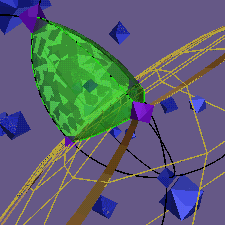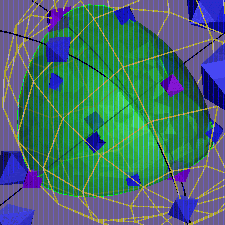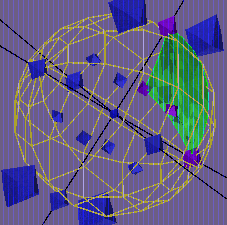


NOTATION: Edge
lengths and dihedral angles are encoded as before:
p = pi/2,
g = pi/3, b = v = 2*pi/3,
with in addition
h = pi/4, i = 3*pi/4.
In the table below each row corresponds
to a single 3-simplex type.
(Note that the set of faces
determines the simplex up to a mirror-symmetry). In the first column each
simplex is assigned a 1-letter code. In the second column the
simplexes are listed lexicographically for convenience in reference.
In the
third column the list of faces is
rewritten in a more topological
order
/\
/1 \
/----\
/ \ 3/ \
/_2_\/_4_\
In the fourth column the six edge lengths of those faces are recorded, in the order 01,02,03,12,13,23 (referring to the vertices in the following copy of the diagram)
0
/\
/ \
1----2
/ \ / \
/ \/ \
0-----3----0
In the fifth column the six dihedrals are recorded, in the same order, except that the first one is the dihedral opposite 01, etc. These dihedrals were calculated as in Vinberg's paper. The sixth column records the relative frequency of each simplex: (1/24) times the number each occurred in an enumeration of all simplexes of the form 1,x,y,z. The seventh column records the volume relative to the total volume of SU(2). See Calculation of Volumes for the explanation of how these volumes were computed.
Highlighted symbols link to conformal images of the
tetrahedra in SU(2), prepared with GeomView modules
developed by Rebecca Frankel.
Code Lexic. Topol. Edges Dihedrals Rel.Freq. Volume
K AAAA AAAA pppppp pppppp 2 1/16
O ABBB BBAB gggppp hhhbbb 8 1/64
N ABCC BCAC ggbppp hhibgg 24 5/192
M ACCD DCAC bbgppp iihbgg 24 11/192
L ADDD DDAD bbbppp iiibbb 8 15/64
Q BBCC CBBC* gbppgg gbppgg 24 1/48
V BBEE BEBE gggpgg ggpbgg 12 1/96
S BDFF DFBF bbbpgg bbpbgg 24 7/96
P CCDD CDCD* bpbgpb bpbgpb 24 5/48
U CCEF ECCF* ggbgpb gpbggb 24 1/32
T CCFF FCCF* bbggpb bpgggb 24 5/96
R DDFF DFDF bbgpbb bbpbbb 12 17/96
BBBB BBBB ggppgg (singular**) 3 0
BCCD DCBC bbppgg (singular**) 12 0
CCCC CCCC bpggpb (singular**) 6 0
DDDD DDDD bbppbb (singular***) 3 1/2
* occur in non-congruent mirror-image pairs.
** these three have volume zero, corresponding
to the decompositions B+B=B+B, D=B+2*C, C+C=C+C
respectively;
*** this degenerate tetrahedron has all dihedrals
equal to pi, and encloses one-half the volume of
the 3-sphere.
Back to Binary Tetrahedral Main Page
Back to Tony's Home Page